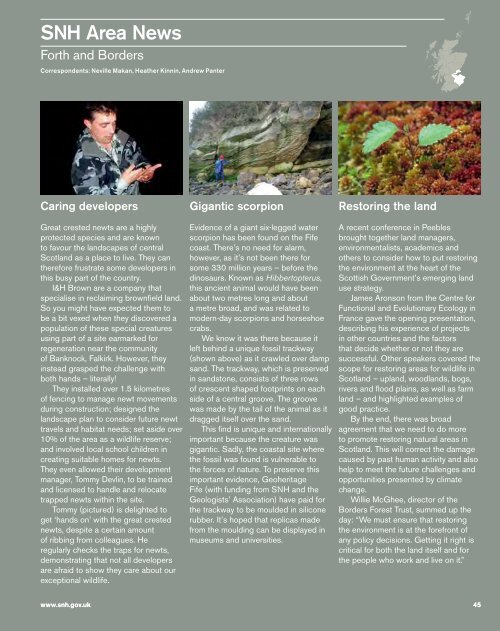Create successful ePaper yourself
Turn your PDF publications into a flip-book with our unique Google optimized e-Paper software.
SNH Area News<br />
Forth and Borders<br />
Correspondents: Neville Makan, Heather Kinnin, Andrew Panter<br />
Caring developers<br />
Great crested newts are a highly<br />
protected species and are known<br />
to favour the landscapes <strong>of</strong> central<br />
<strong>Scotland</strong> as a place to live. <strong>The</strong>y can<br />
therefore frustrate some developers in<br />
this busy part <strong>of</strong> the country.<br />
I&H Brown are a company that<br />
specialise in reclaiming brownfield land.<br />
So you might have expected them to<br />
be a bit vexed when they discovered a<br />
population <strong>of</strong> these special creatures<br />
using part <strong>of</strong> a site earmarked for<br />
regeneration near the community<br />
<strong>of</strong> Banknock, Falkirk. However, they<br />
instead grasped the challenge with<br />
both hands – literally!<br />
<strong>The</strong>y installed over 1.5 kilometres<br />
<strong>of</strong> fencing to manage newt movements<br />
during construction; designed the<br />
landscape plan to consider future newt<br />
travels and habitat needs; set aside over<br />
10% <strong>of</strong> the area as a wildlife reserve;<br />
and involved local school children in<br />
creating suitable homes for newts.<br />
<strong>The</strong>y even allowed their development<br />
manager, Tommy Devlin, to be trained<br />
and licensed to handle and relocate<br />
trapped newts within the site.<br />
Tommy (pictured) is delighted to<br />
get ‘hands on’ with the great crested<br />
newts, despite a certain amount<br />
<strong>of</strong> ribbing from colleagues. He<br />
regularly checks the traps for newts,<br />
demonstrating that not all developers<br />
are afraid to show they care about our<br />
exceptional wildlife.<br />
Gigantic scorpion<br />
Evidence <strong>of</strong> a giant six-legged water<br />
scorpion has been found on the Fife<br />
coast. <strong>The</strong>re’s no need for alarm,<br />
however, as it’s not been there for<br />
some 330 million years – before the<br />
dinosaurs. Known as Hibbertopterus,<br />
this ancient animal would have been<br />
about two metres long and about<br />
a metre broad, and was related to<br />
modern-day scorpions and horseshoe<br />
crabs.<br />
We know it was there because it<br />
left behind a unique fossil trackway<br />
(shown above) as it crawled over damp<br />
sand. <strong>The</strong> trackway, which is preserved<br />
in sandstone, consists <strong>of</strong> three rows<br />
<strong>of</strong> crescent shaped footprints on each<br />
side <strong>of</strong> a central groove. <strong>The</strong> groove<br />
was made by the tail <strong>of</strong> the animal as it<br />
dragged itself over the sand.<br />
This find is unique and internationally<br />
important because the creature was<br />
gigantic. Sadly, the coastal site where<br />
the fossil was found is vulnerable to<br />
the forces <strong>of</strong> nature. To preserve this<br />
important evidence, Geoheritage<br />
Fife (with funding from SNH and the<br />
Geologists’ Association) have paid for<br />
the trackway to be moulded in silicone<br />
rubber. It’s hoped that replicas made<br />
from the moulding can be displayed in<br />
museums and universities.<br />
Restoring the land<br />
A recent conference in Peebles<br />
brought together land managers,<br />
environmentalists, academics and<br />
others to consider how to put restoring<br />
the environment at the heart <strong>of</strong> the<br />
Scottish Government’s emerging land<br />
use strategy.<br />
James Aronson from the Centre for<br />
Functional and Evolutionary Ecology in<br />
France gave the opening presentation,<br />
describing his experience <strong>of</strong> projects<br />
in other countries and the factors<br />
that decide whether or not they are<br />
successful. Other speakers covered the<br />
scope for restoring areas for wildlife in<br />
<strong>Scotland</strong> – upland, woodlands, bogs,<br />
rivers and flood plains, as well as farm<br />
land – and highlighted examples <strong>of</strong><br />
good practice.<br />
By the end, there was broad<br />
agreement that we need to do more<br />
to promote restoring natural areas in<br />
<strong>Scotland</strong>. This will correct the damage<br />
caused by past human activity and also<br />
help to meet the future challenges and<br />
opportunities presented by climate<br />
change.<br />
Willie McGhee, director <strong>of</strong> the<br />
Borders Forest Trust, summed up the<br />
day: “We must ensure that restoring<br />
the environment is at the forefront <strong>of</strong><br />
any policy decisions. Getting it right is<br />
critical for both the land itself and for<br />
the people who work and live on it.”<br />
www.snh.gov.uk 45

















